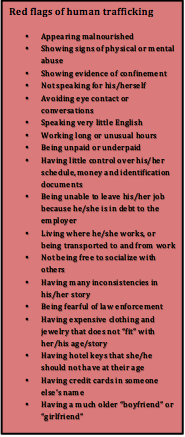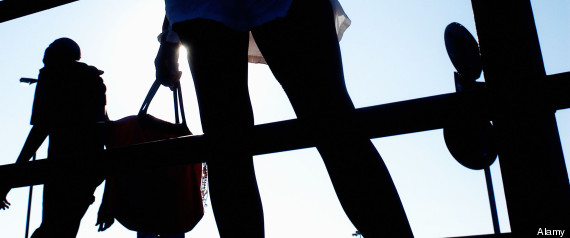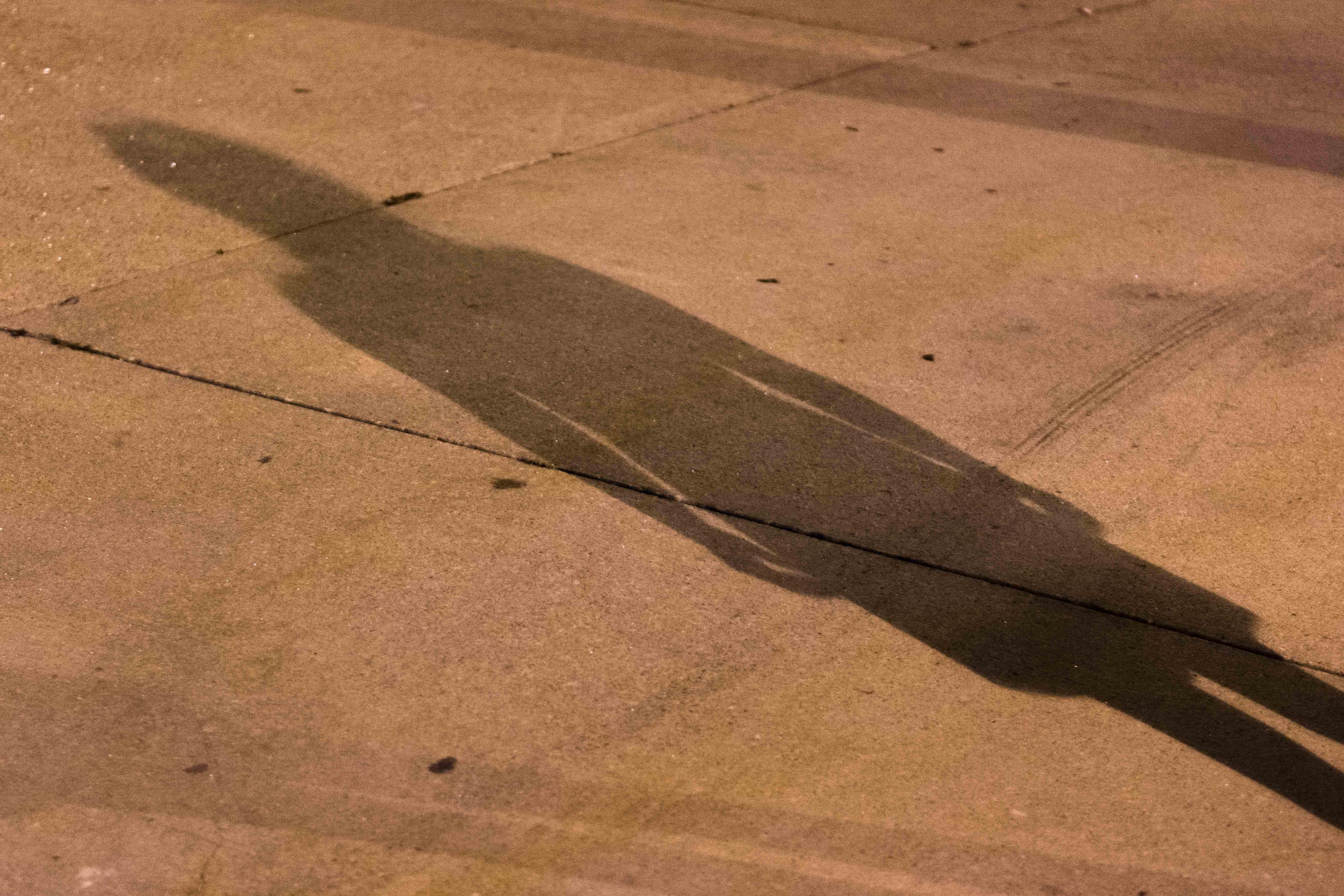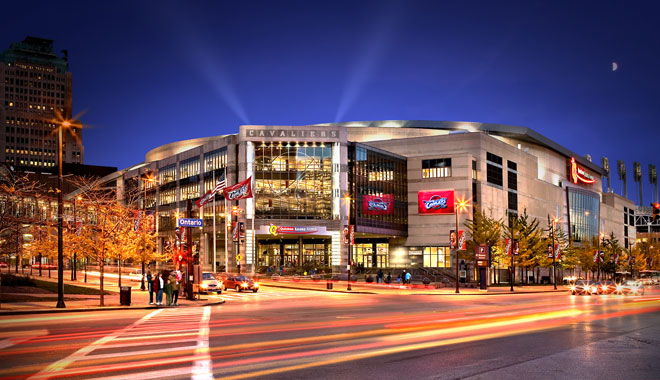Human trafficking an increasing concern as Cleveland’s RNC approaches
September 18, 2015
“Human trafficking happens here.”
Karen Walsh, director of the Collaborative Initiative to End Human Trafficking, drops this sentence unassumingly. It’s not anything special for her to say about Ohio; it’s just a fact.
“It’s not a new crime,” she continues. “At its heart, it is really involuntary servitude or today’s practice of slavery.”
Federal law defines human trafficking as “a form of modern-day slavery where people profit from the control and exploitation of others.” Trafficking includes both labor and sex trafficking; in Ohio, it is estimated that 88 percent of human trafficking involves sex slavery.
“Criminals have begun shifting from trafficking narcotics and weapons to trafficking humans,” wrote the Ohio Human Trafficking Task Force in a 2012 report. “Drugs and guns must be restocked in order to make a profit, whereas a person is seen as a renewable asset that can be resold time and time again, multiple times in one night.”
Statistics on human trafficking vary greatly. By nature the billion-dollar enterprise is underground and hidden, making it difficult for researchers to get an accurate picture of what is going on.
In one estimate, there are as many as 300,000 people at risk of human trafficking in the United States. They are mostly underage girls, especially minorities. Many are recruited by a friend or boyfriend. Some start sex work voluntarily, then move into involuntary sex work due to drug and alcohol addiction or coercion.
The National Human Trafficking Resource Center hotline reports that Ohio had the sixth most calls reporting trafficking of any state.
Ohio’s five major highways are partially to blame for this prevalence in trafficking; with ample connections to other states and to the Canadian border, the state provides accessible ways for traffickers to transport victims. Large urban centers with high poverty rates also contribute.
“Cleveland has very high rates of poverty, with historically few job opportunities and resources,” said Rachel Lovell, Senior Research Associate with the Begun Center for Violence Prevention Research and Education at Case Western Reserve University’s Jack, Joseph, and Morton Mandel School of Applied Social Sciences. “This creates a lot of social issues, including trafficking.”
Lovell said that Cleveland is a supplier city; she attributes this to economic deprivation and a lack of employment opportunities. From Cleveland, people are taken to other, higher population areas, like Chicago.
However, some caution that the statistics about Ohio may be overblown.
“The state, the Federal Bureau of Investigation and some nonprofits have raised attention and awareness to the issue,” said associate professor of sociology Brian Gran. “One of the reasons that it may seem bigger here is the greater awareness and effort to try to stop it and deal with the problem. But it may also be that it’s happening here more.”
“Northern Ohio law enforcement has worked human trafficking matters aggressively over the past several years,” said FBI Special Agent Vicki Anderson. “Therefore, we have had statistics reflecting that. We are portrayed as possibly being vulnerable, but it is really that we have made this one of our priorities and the numbers have reflected our efforts.”
Although common perceptions of trafficking portray it as an international issue, affecting mostly other countries and those not from the United States, the Bureau of Justice Statistics estimates that 83 percent of people sex trafficked in this country are U.S. citizens.
“Trafficking is domestic,” said Gran. “It’s from our backyard and it’s shocking. There are young people from Cleveland Heights, Avon, Elyria that are trafficked.”
According to Gran, there is anecdotal evidence that Cleveland State University students have been pushed into trafficking rings.
“I worry about here at Case. It’s scary because it’s hidden, because so much of it is done by the Internet,” he said. “I think that this university should be vigilant… it’s always possible for someone to fall through the cracks.”
The upcoming RNC in Cleveland is expected to bring in tens of thousands of people to the downtown area.
The upcoming Republican National Convention (RNC) provides a unique challenge for Cleveland, because with any large influx of people, there is also a large increase in trafficking.
“Any event that brings large crowds of people to any city is concerning for possible human trafficking, whether that be a large sporting event, a large national conference, etc.,” said Anderson.
In 2012, the RNC was held in Tampa. An estimated 40,000 to 45,000 people attended the convention.
“Any time you have a lot of commerce or activity, you will get an increase in lots of different things,” said Lovell. “Selling sex is no different than that.”
The increase in supply is meant to correlate with an increase in demand.
“If you have a lot of victims, you also have a lot of johns,” said Gran. “If you have some notable people, I’d be interested to see if they are actually prosecuted and go to jail. I would like to know if the court system is ready for that.”
Leading up to the RNC, community members, including Lovell and representatives from the Collaborative, the Cleveland Rape Crisis Center (CRCC) and Bellefaire JCB, have been meeting monthly since November of 2014 to coordinate with each other and prepare for the likely increase in trafficking.
Their work focuses primarily on three parts: creating a network to be prepared in terms of response and intervention, training hospital personnel to recognize red flags for human trafficking victims and raising awareness within the general public.
“If someone is identified and law enforcement or the hotline is called, we want to have a well-oiled machine of professionals to help assist that person,” said Sondra Miller, president and CEO of the CRCC.
“The RNC provides the city with an opportunity to do its training better, do its protocols better and make people more aware so that between now and the convention we can deal with human trafficking, and we can deal with it long after the convention is gone,” said Walsh.

In recent years, Ohio has made more of a push for anti-trafficking laws, resulting in identification of 181 victims and arrests of 98 traffickers in 2014. Of those 98 arrests, 17 have led to convictions, according to a report from the office of Attorney General Mike DeWine.
House Bill 262, Ohio’s Safe Harbor Law, laid out a three-pronged approach to the issue: recategorizing the crime as a first-degree felony, raising the mandatory minimum sentence to 10-15 years; beginning a diversion program for juvenile victims to get protection and treatment through the juvenile justice system; and expunging the records of adult victims with prior convictions of prostitution and solicitation.
“In the past, the victim may have been arrested and charged with prostitution,” said Miller. “They were treated as a criminal without understanding that they may have been coerced into participating in the sex trade against their will.”
“The Cuyahoga County court system is really on the forefront of some of this,” said Gran. “People used to be charged with prostitution and treated as a juvenile offender. Now they are understood as a victim.”
Also in 2012, the office of Governor John Kasich formed the Ohio Human Trafficking Task Force, which brought together members of 11 state agencies, ranging from education to medicine to cosmetology, to create a plan of action for the government.
According to Gran, law enforcement is now stronger at the state level, where police officers know the signs of trafficking. Additionally, officers are increasingly communicating with schools and administrators to gain more insight.

The Collaborative Initiative to End Human Trafficking, which was formed in 2007, has spearheaded much of the work against human trafficking in Ohio. Its mission is to educate and advocate for the prevention and abolition of human trafficking and to connect services on behalf of trafficked persons, according to the group’s website.
The Collaborative aims to educate people in law enforcement, social services, the medical field and more so that they know how to properly identify and deal with human trafficking.
“What we want to do is educate all those systems to understand the issue so that they can best respond from whatever their expertise is,” said Walsh. “We’ll go wherever people are willing to listen.”
However, for those who are identified as trafficked, the resources available are minimal.
According to Lovell, victims of trafficking are some of the most marginalized people in the country and need as much help as possible.
“Unfortunately, that’s very hard because it is very expensive to provide that level of support for people,” she added.
Lovell is currently working on a grant that could house up to nine women who self-identify as trafficked in the Hitchcock Center for Women, where they would be provided with drug treatment and other services for nine months in order to help lower the high rates of recidivism among trafficked women.
“That’s what these people really need, the full thing,” she said. “What Cleveland has done, which is a good first step, is set up immediate housing to get the victim out of a bad situation, but it’s similar to domestic violence situations… To really address the situation you have to be able to provide lots of resources, patience and time to work through what they need.”
The FBI provides some services to victims through their victim services coordinator. The coordinator refers victims to community support, based on their needs.
Victims deal with everything from medical issues to drug and alcohol abuse problems to trauma. Fear and trust are also huge issues. Many human trafficking victims began in the trade because of a boyfriend or family member, who they may still believe they trust. By some estimates, about one-third of trafficked children are trafficked by an immediate family member, which makes removing them from the situation even more difficult.
“People may not identify as being trafficked,” said Lovell. “They may not want to testify, even if they hate the trafficker, because they don’t see that person as their captor, but as their boyfriend or partner. They have a personal relationship with them, which makes getting them to identify the problem and testify difficult.”
“They may not recognize that they are a victim,” said Walsh.
Bellefaire, a child welfare agency, became involved in the issue through their work with homeless children.
According to Karen McHenry, Homeless Youth programs director, a youth will be solicited for sex within 48 hours of being on the street. The organization runs a 24/7 hotline for homeless and missing youth, through which they collaborate with community partners and law enforcement to help get victims the care that they need.
“These kids are really invisible to most people,” she added. “Unless you are asking the right questions, connecting with these kids, presenting yourself as a safe person, you won’t know that these kids need help.”
The CRCC also provides a 24/7 hotline, specific to trafficking victims, through Project STAR, or Sex Trafficking Advocacy and Recovery. Launched in April of 2013, the hotline receives between 100 and 150 calls per year.
“The victims come forward with a wide range of needs,” said Miller. “No two calls are exactly the same.”
Once they receive a call, the CRCC connects the victims with their services, which include individual and group counseling as well as criminal justice advocacy, as well as other agencies who can help with food, shelter and any other needs the victim may have.
Miller says that, of the adult women who come into the CRCC for help, about one-third have a history of trafficking.
“When someone walks through our door, we don’t ask ‘are you a victim of human trafficking’ because most people have no idea what that means and would say no,” said Miller.
Instead, the agency prompts them with questions about whether anyone has ever forced them to have sex for money.
“We reframed the questions to match people’s experiences,” said Miller.

Sunrises over land and sunsets over Lake Erie are visible from Downtown Cleveland. July is coming to an end and the fall semester is only a little over a month away.
“[Human trafficking] happens everywhere,” said McHenry. “Accept that it happens and be aware of it and the warning signs.”
“A lot of times we just rush through our day and we don’t really take a second to say ‘wow, that girl hasn’t been to class in two weeks,’” she continued. “Has anybody noticed? Has anybody paid attention to her? Become aware of the issue, then tell five people.”
Awareness is key to solving the issue, from every standpoint.
“Be the best in your profession and educate those in your profession regarding human trafficking, because the way the nurse responds is different than the doctor, than the teacher,” said Walsh. “Bring awareness of this crime to your particular field.”
If you recognize any of the signs of human trafficking, report it to the National Human Trafficking Resource Center Hotline (888-373-7888), Bellefaire JCB’s 24/7 Homeless and Missing Youth Hotline (216-570-8010) or the Cleveland Rape Crisis Center’s Project STAR 24/7 Hotline (855-431-7827). As McHenry notes, “If you see something, say something.”

